Would pumpkin flowers turn into PUMPKINS? Or want to eat them instead? I am there to answer you. To begin with, yes, the pumpkin flower is edible!
I understand that you might compare pumpkins with squash. Sometimes any round orange squash is called a PUMPKIN too!
I tell you that pumpkins belong to the same genetic family called Cucurbita as squash. You can depend on my gardening knowledge about pumpkins plant over all these years.
FEEL CONTENT with the information provided here.
Learn about PUMPKINS PLANTS:
- Types of plant flowers
- Their blooming problems
- Why, When, How to bloom them & more!
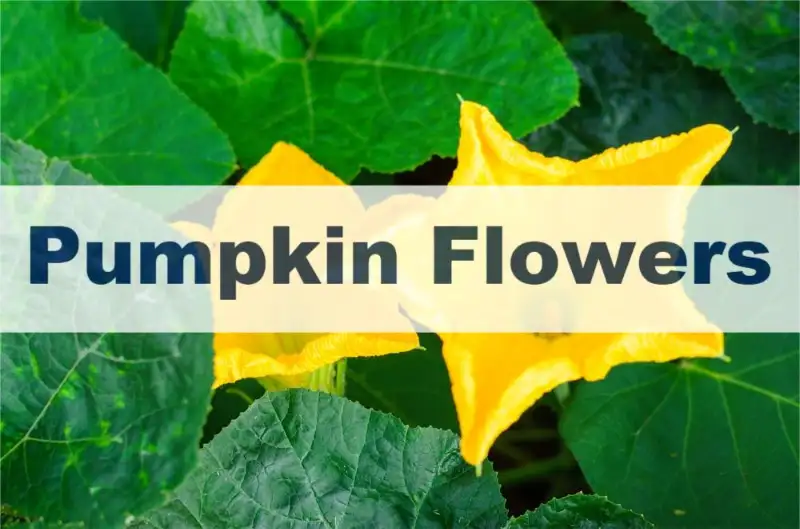
What are the Types of Pumpkin Flowers and Their Difference?
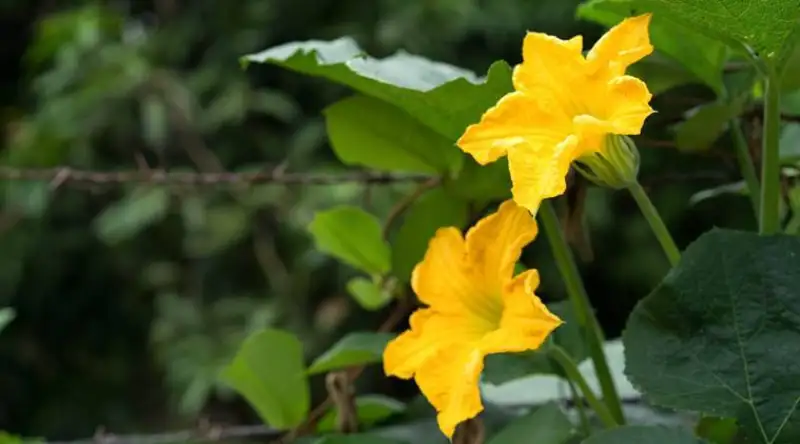
The flowers from pumpkin seeds are FUNNEL-SHAPED that are bright orange or yellow. They may be about 4-5 inches in diameter. Pumpkin blossoms are either male flowers or female ones.
Both look different and contribute differently to pumpkin fruit growth. The pumpkin species and environment determine flowering time. The pumpkin plant makes both male and female flower parts. They are called staminate and pistillate, respectively.
There’s a clear difference between the male and female pumpkin flowers. Male pumpkin flowers come right off the vine. In contrast, female pumpkin flowers have a small fruit growing at the base near the stem.
Don’t worry if the pumpkin vine flowers come early in the season but don’t produce fruit. Male flowers bloom first, so bees take them along their POLLEN PATH.
Waiting for the female flowers may work. Female pumpkin flowers bloom TWO WEEKS AFTER MALE FLOWERS are on them.
Problems Related to Pumpkin Flowers During the Blooming Stage
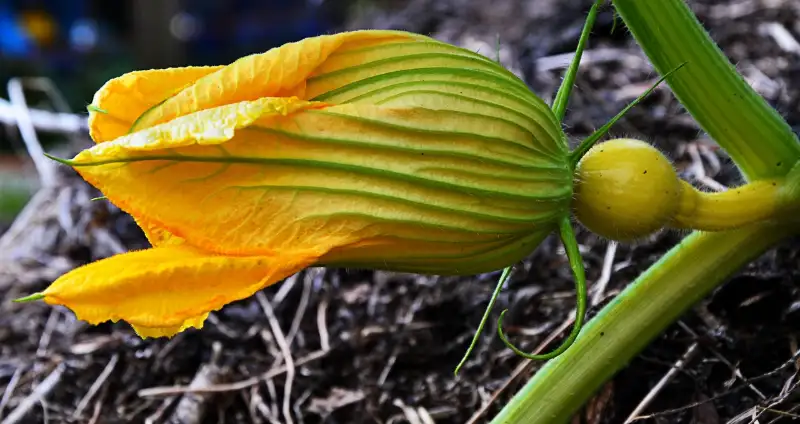
Let’s learn the problems related to pumpkin plant flowers during the blooming stage:
Flowerless
Pumpkin gardeners anxiously expect blossoms and fruit. Since last year, no pumpkin! I suggest using phosphorus fertilizer. This results in plants blooming and fruiting.
Avoid using Nitrogen fertilizers during the bloom stage. They might also DELAY BLOSSOMING.
Only Male Flower
Male blossoms usually arrive first in large numbers. After a week without ladies, you start to worry. Female pumpkin flowers appear 10-14 days after the first male (**occasionally longer!**). Only a few ladies will appear. Males usually OUTNUMBER females.
Only Female Flowers
Female pumpkin flowers rarely appear first. This might sometimes happen on pollen-laden male blooms but is short-lived. The male flowers eventually arrive. Season-long, more female and male blossoms will come for SUCCESSFUL PUMPKIN POLLINATION.
Female flowers sometimes arrive first. This may happen due to soil fertility levels, as some people say. Or others say early-season cold snaps may predispose the plant to this situation.
Check the fertility of the soil. Keep suitable to high phosphorus levels. Avoid too much nitrogen; its level should be MODERATE.
Do two things for less male blossom conditions. First, place ripe male flowers in a glass of water and refrigerate. Do hand pollination with them as needed. They last a week when refrigerated. Second, ASK A PUMPKIN-GROWING FRIEND to get some male blooms for hand pollination.
Unopened Female Flowers
Pumpkins are usually missed by growers when finding any OPEN FEMALE FLOWER. The reason is female pumpkin flowers open one morning and close before noon. Cloudy and rainy weather can prevent their opening.
The Reason Your Pumpkin Isn’t Blooming

Pumpkin plant not blooming – why? IMPATIENCE is a common reason for this. Pumpkin plants bloom after establishing numerous critical stems.
When do plants blooms? The time depends on the variety, climate, and when you installed them outdoors. Expect plants to BLOOM IN SIX TO EIGHT WEEKS after planting.
Now let’s discuss FLORAL SEX. Pumpkins, like squash, grow both male and female flowers for pollination and fruit. Male flowers bloom earliest. Female pumpkin flowers appear after 10 to 14 days.
You can have a look at the reasons for pumpkins not blooming as follows:
- You might not be looking often enough to see male and female flowers if you didn’t see any during this time. Each plant flower lasts one day and opens in the morning.
When there are no female flowers to pollinate, early male blooms die off immediately. Early blossoms require a keen eye. Some plants’ blooms might miss in the stems.
- You may also be expecting blooms too soon. Before the first yellow flower appears, healthy pumpkin vines should be a meter long. The time pumpkin plants flower depends on the soil, sunlight, variety, & other factors.
Each affects plant blooming. Controlling the ground’s fertility and adding flowering nutrients can boost plants blooming.
- Pumpkins HATE OVERHEAD WATERING. Many fungal diseases can harm leaves and buds as they form due to this. Heavily contaminated buds may abort, leaving your plant bloomless. Pumpkin plants don’t blossom for one more reason that is soil fertility.
- Lack of potassium, a plant’s macronutrient, can IMPAIR BLOOMING. It is available in the form of potash or other potassium compounds in floral and fruit meals. Phosphorus is usually accountable for flower and fruit production.
After six to eight weeks of planting pumpkin vines, stop nitrogen applications. The pumpkin vines must have nutrition to grow rampant stems in soils with organic matter.
Suggested reading: Water Pumpkin Properly: Detailed Guide
When do Pumpkins Bloom? How Long Does It Last?
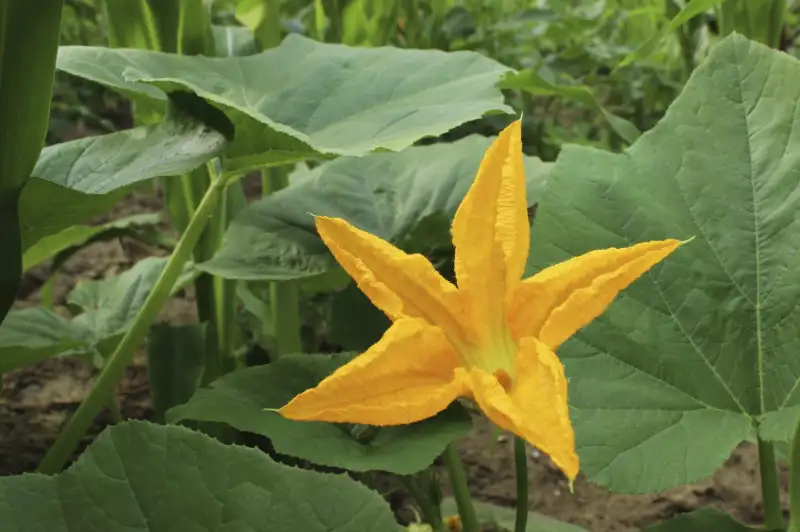
Pumpkins flower somewhere between the end of spring and the beginning of summer. This time of blossoming can extend for a few weeks. Flowers are often open during the day and closed at night.
On the pumpkin vine, male pumpkin flowers appear before their female counterpart. According to the University of Minnesota Extension, “pumpkin blossoms last 4 hours. A male flower only lasts a few hours”.
A NEW MALE PUMPKIN FLOWER opens every morning to lure in the bumblebees or other pollinators. The pumpkin fruit will take the place of the flowers once the blooming completes.
Suggested reading: How Many Pumpkins Per Plant?
How to Tell If Pumpkin Got Pollinated?
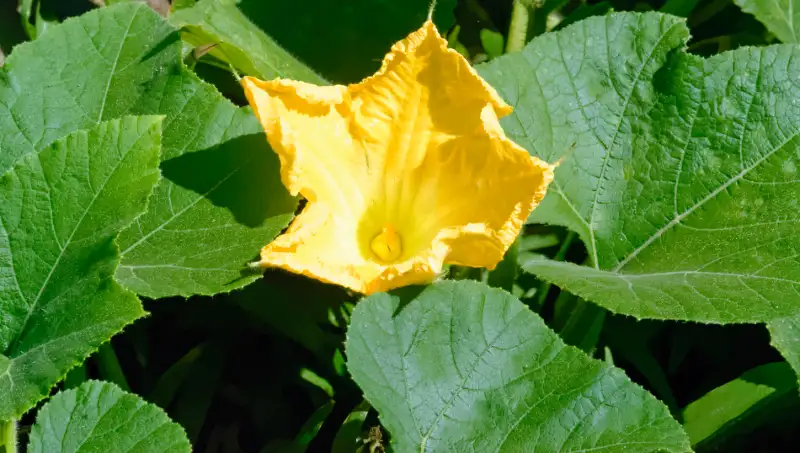
Bumblebees, honey bees, and squash bees are the common pollinators of pumpkin blooms. Morning is the prime time for pollination when flowers and bees are most active. TRANSFER POLLEN FROM A BLOSSOM to a developing fruit requires many visits from bees.
Each flower can be seen open only one day. If a female pumpkin flower isn’t pollinated on that day, it will turn yellow and EVENTUALLY DIE. To find out if bees are busy in a field, check it out early in the day.
Do this before the extreme temperatures when blooms close. Even if there is only sporadic bee activity and no existing hives, it is good to bring hives for bees.
Pollen grains must sprout. They should grow after pollination (pollen transfer to the female pumpkin flower). It will lead to fertilizing each ovule, eventually developing into a seed. The pumpkin fruit won’t survive without this. If the pumpkin seeds don’t germinate, the pumpkin will not grow.
Nutrition of Pumpkin Flowers
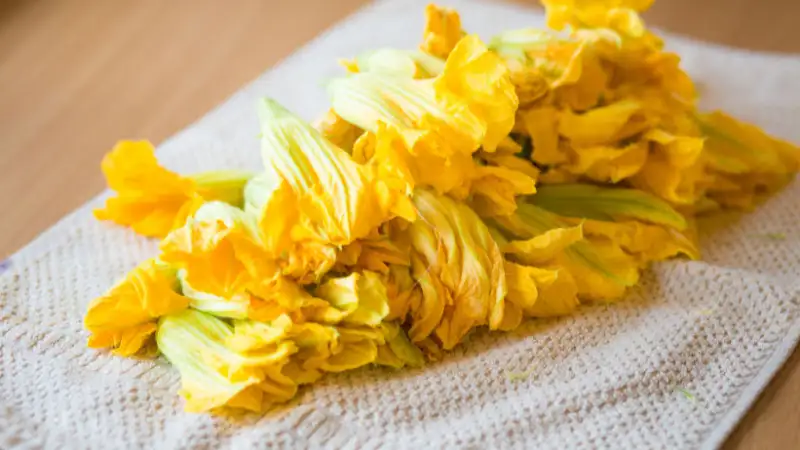
Pumpkin flower has fiber, copper, folate, and vitamin a, yet it only has a few calories and fat per serving.
FoodData Central told the nutrients found in 1 cup (134 grams) of cooked pumpkin blossom:
- Energy: 20
- Carbohydrates: 4.5 g
- 1.5 g of Protein
- 0.1 g of fat
- 1.2 g of fiber
- 15 percent of DV (Daily Value) for Copper
- 14 percent of DV for Folate
- 13 percent of DV for Vitamin A
- 8 percent of DV for Magnesium
- 7 percent of DV for Vitamin C
- 7 percent of DV for Iron
National Institutes of Health Office of Dietary Supplements verified pumpkins have beneficial minerals. The copper in pumpkin blossoms is exceptionally high. Copper is a mineral your body requires for making energy.
Also, folate can be found in relatively high concentrations per serving. It is a B VITAMIN essential for proper protein metabolism and DNA synthesis.
Pumpkin flowers, both male ones and female ones, contain about 13 percent of the daily value (DV) for vitamin A.
It is vital for normal bone, tooth, and skin development. It supports the proper functioning of the heart, eyes, and lungs.
FAQs about Pumpkin Flowers
1. Does each flower turn into a pumpkin?
No, not every flower turns into a pumpkin. Male flowers pollinate female flowers. Female flowers turn into pumpkins which get pollinated by the male blossoms. Other female flowers eventually die off.
2. Are pumpkin flowers safe to eat?
The pumpkin plant flowers are safe to eat, raw and cooked. It is used in salads or dishes like stir-fry, quesadillas, or stuffed pumpkin flowers.
3. Should you pick pumpkin flowers?
You can pick pumpkin flowers as and when required for cooking purposes. But ensure to leave some male and female flowers on the pumpkin plant. It will maintain enough successful pollination and fruit production.
4. Can you leave pumpkin on the vine for too long?
No, you can’t leave pumpkins on the vine for too long, as they will rot. Frost can ruin the blossoms, their tips, and other pumpkin fruits. You’ll reap the rewards if you harvest pumpkins at the ideal time.
What’s Next
First, knowing the types of pumpkins flowers and their differences. Get into problems both male and female flower face during the blooming stage.
You learned why pumpkin flowers are not blooming, when they flower, and how long they last. Then learning when to say they got pollinated and their nutrition.
If you wonder about pumpkins or other flowers, browse through AsterGardening to read similar articles.
All your queries related to flowers, plants, and pumpkin fruits will be answered. We will gladly provide you with everything that you are seeking.
Find this article interesting? Please SHARE IT WITH YOUR PEERS and FAMILY. We are willing to resolve all of your questions!
